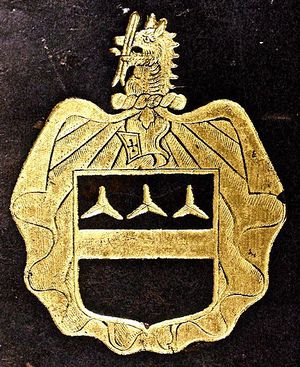Difference between revisions of "William Rich b.1567"
m (David moved page William Rich to William Rich b.1567 without leaving a redirect) |
|||
| (One intermediate revision by one other user not shown) | |||
| Line 3: | Line 3: | ||
[[File:RichWilliam1.jpg| thumb | Armorial stamp of William Rich (British Armorial Bindings) ]] | [[File:RichWilliam1.jpg| thumb | Armorial stamp of William Rich (British Armorial Bindings) ]] | ||
====Biographical Note==== | ====Biographical Note==== | ||
| − | The only biographical information currently available is that Rich was born in [[date of birth::1567]], the son of [[ | + | The only biographical information currently available is that Rich was born in [[date of birth::1567]], the son of [[crossreference::Robert Rich]], and that he was admitted to the [[organisations::Middle Temple]] in 1605. |
====Books==== | ====Books==== | ||
Latest revision as of 23:26, 20 September 2022
William RICH b.1567
Biographical Note
The only biographical information currently available is that Rich was born in 1567, the son of Robert Rich, and that he was admitted to the Middle Temple in 1605.
Books
Only about a dozen books can be traced owned by Rich, but their bindings and annotations suggest someone who took an active interest in his books, and his library is bound to have been larger than what now survives. All the known books, now in numerous libraries, are English language/STC books with imprints from the 1560s to the 1610s. His copy of Antonio de Guevara, The Dial of Princes (1582), now in the British Library (C.108.c.14) contains the printed label “This booke was bound by John Browne, citizen and stationer of London, dwelling in Little Britaine … For William Rich, of the Middle Temple, London” (STC 3908.3); another example is in Sion College Library. Examples: Cambridge UL SSS.44.5, National Art Library CLE DD9, John Rylands Library R128603.
Characteristic Markings
Most of Rich’s books are identified from his armorial binding stamp gilt-tooled on the covers; CUL SSS.44.5 is a handsome binding with cornerpieces and gilt spine decoration. He sometimes inscribed his name (“Rych me possidet”) and his books show signs of extensive reading and annotation, often with distinctive hash-mark like marginal symbols which are found in several of his books.
Sources
- British Armorial Bindings.
- Pollard, A. W. ‘An English bookbinder’s ticket, c.1610?’, The Library 3rd ser 12 (1931), 332-335.
- Armorial binding of William Rich in Sion College Library.
